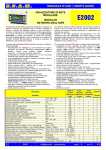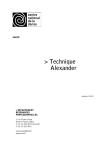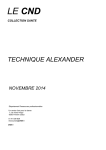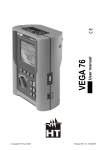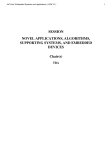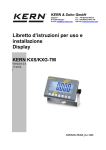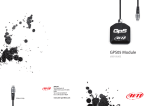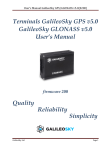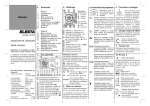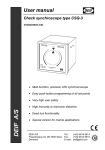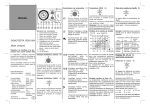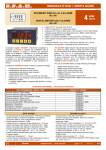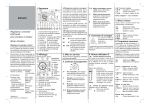Download manuale d`uso / user`s guide
Transcript
E.S.A.M. MANUALE D’USO / USER’S GUIDE ANALIZZATORE DI RETE DI PRECISIONE E1100 HIGH ACCURACY NETWORK ANALYZER L’analizzatore di rete E1100, interamente progettato e sviluppato da ESAM, è costruito per soddisfare tutte le moderne esigenze di misura e controllo dei parametri elettrici di una rete trifase. L’elevata precisione di misura lo rende particolarmente adatto per impieghi in laboratori, sistemi di acquisizione e di regolazione, ecc. Basato su un microprocessore di ultima generazione, è dotato di un circuito di misura con cambio portata automatico e di una interfaccia seriale RS485 veloce. L’accurato dimensionamento di ogni componente (es. circuiti stampati omologati UL) e la taratura con strumenti certificati SIT garantiscono la massima precisione ed affidabilità in ogni condizione di utilizzo. Le principali caratteristiche dell’analizzatore di rete E1100 sono le seguenti: elevata precisione di misura: 0.2% della lettura dal 5 al 100% del campo di misura, frequenza AC da 45 a 65 Hz elevate prestazioni con forme d’onda distorte: 256 campioni per periodo di rete AC, banda passante di ingresso 2 kHz (-3dB) multiportata automatico (7 campi di misura per tensioni e correnti, G = 1,2,4,8,16,32,64) calcolo ogni mezzo periodo di rete AC di tensioni di fase e concatenate RMS, correnti di fase RMS e corrente di neutro RMS, correnti e tensioni istantanee di picco, frequenza, potenze attive, reattive e apparenti, fattore di potenza di ciascuna fase e del sistema trifase media valori letti programmabile da mezzo periodo di rete AC (minimo) a 1 secondo (max) analisi armonica di tensioni e correnti di fase, calcolo distorsione armonica totale (THD) rilevazione valori minimi e massimi di tutte le misure interfaccia seriale isolata RS485, 1200 … 115200 baud, protocollo Modbus RTU inserzione trifase con 3 TA o 2 TA (ARON) o monofase con 1 TA rapporti TA e TV configurabili montaggio su profilato DIN EN50022-35 The network analyzer E1100, entirely designed and developed by ESAM, is built to comply with all the modern requirements of measure and control of electrical parameters in a 3-phase network Due to its high measuring accuracy, E1100 is particularly suited for laboratory applications, sophisticated data acquisition and control systems, etc. It features a microprocessor of the latest generation, an autoranging analog input stage and a fast RS485 serial interface. The careful choice of every component (e.g. UL recognized printed circuits) and the calibration with EAL.SIT certificated devices, provide the highest precision and reliability in every condition of use. The main features of the network analyzer E1100 are the following: high accuracy: 0.2% of reading, from 5% to 100% of measuring range, AC frequency 45 to 65 Hz high accuracy with distorted waveforms: 256 samples every AC period, 2kHz analog input bandwidth (-3bB) autorange (7 ranges for input voltages and currents, G = 1,2,4,8,16,32,64) calculation every half AC period of phase and linked RMS voltages, phase RMS currents and neutral RMS current, instantaneous peak voltages and currents, frequency, active, reactive and apparent powers, power factor of each phase and of 3-phase system averaging of measured values programmable from half AC period (min) to 1 second (max) Harmonic analysis of phase voltages and currents, calculation of total harmonic distortion (THD) Min and max values of every reading RS485 insulated serial interface, 1200 ... 115200 baud, Modbus RTU protocol 3-phase connection with 3 CT or 2 CT (ARON) or single-phase with 1 CT configurable CT and VT ratios rail DIN EN50022-35 mounting Grandezze misurate Measured Variables Unità di misura Measured units Tensioni di fase / Phase Voltages Tensioni concatenate / Linked Voltages Tensioni istantanee di picco / Instantaneous peak voltages Tensione concatenata media / Linked average Voltage Correnti / Currents Correnti istantanee di picco / Instantaneous peak currents Corrente di neutro / Neutral current Corrente media / Average current Distorsione armonica / Total harmonic distortion Potenze attive / Active Powers Potenza attiva totale / Total Active Power Potenze reattive / Reactive Powers Potenza reattiva totale / Total Reactive Power Potenze apparenti / Apparent Powers Potenza apparente totale / Total Apparent Power Fattore di potenza di fase / Phase power factor Fattore di potenza totale / 3-phase power factor Frequenza / Frequency Ampiezza armoniche / Amplitude of harmonics ( V1, I1, V2, I2, V3, I3) Valori massimi e minimi di tutte le misure / Min and Max values of every reading Senso ciclico delle fasi / Phase sequence ) E1100 [email protected] www.esam.biz V1N V2N V3N V12 V23 V31 V1pk V2pk V3pk Vtm I1 I2 I3 I1pk I2pk I3pk Ineu Itm Thd V1-V2-V3 Thd I1-I2-I3 P1 P2 P3 Ptot Q1 Q2 Q3 Qtot S1 S2 S3 Stot PF1 PF2 PF3 PF Frequency […]min […]max page 1 - 8 [V] [V] [V] [V] [A] [A] [A] [A] [%] [W] [W] [VAR] [VAR] [VA] [VA] [Hz] [%] […] rev. 1.09 0512 E.S.A.M. MANUALE D’USO / USER’S GUIDE DATI TECNICI TECHNICAL DATA tensione nominale Vn: 230V fase/neutro, 400V fase/fase campo di misura tensione: 0 … 1.2 Vn corrente nominale d’ingresso In: 5A campo di misura corrente: 0 … 1.2 In sovraccarico permanente: 1.5Vn, 2In sovraccarico istantaneo (1 sec.): 2Vn, 20 In rapporto TA esterno impostabile: 1 … 99999 rapporto TV esterno impostabile: 1 … 99999 tempo di media valori misurati: ½ periodo AC … 1 sec classe di precisione per tensioni, correnti e potenza attiva: ± 0,2% della lettura (5 ... 100% del campo di misura, 45 ... 65 Hz) coefficiente di temperatura: ±0,01%/°C interfaccia seriale RS485: 1200 … 115200 baud, Modbus RTU acquisizione dati veloce: tipico 40 variabili in circa 40 msec. alimentazione ausiliaria in corrente alternata: 115-230V 50/60Hz oppure in opzione: 24V o 100V o 400V ±15% - consumo ≤3VA alimentazione ausiliaria opzionale in corrente continua: 12V oppure 24V oppure 48V oppure 110V oppure 220V ± 10% (Morsetti : [V0] - e [V2] +) - consumo: ≤ 3W conforme a EN61010-1 (sicurezza) e EN61326 (EMC) isolamento fra ingressi V e ingressi I: 4kV (60sec,50Hz) isolamento fra due ingressi I: 4kV (60sec,50Hz) isolamento fra ingressi e altri morsetti: 4kV (60sec,50Hz) isolamento RS485 / alim. Ausiliaria: 2kV / 60sec. 50Hz temperatura di funzionamento -10° … +55°C temperatura di impiego +5° … +40°C temperatura di immagazzinamento -30° … +70°C temperatura di riferimento +20°C nominal voltage Vn: 230V phase/neutral, 400V phase/phase input voltage range: 0 ... 1.2Vn nominal input current : 5A input current range: 0 … 1.2 In continuous overload: 1.5Vn, 2In instantaneous overload (1 sec): 2Vn, 20In programmable external TV ratio: 1 ... 99999 programmable external TV ratio: 1 ... 99999 averaging time interval: ½ AC period ... 1 sec accuracy (voltage, current, active power): ± 0,2% of reading (5. ... 100% of input range, 45 ... 65 Hz) temperature coefficient: ±0,01%/°C RS485 serial interface: 1200 ... 115200 baud, Modbus RTU fast data acquisition: typically 40 variables in about 40 msec. a.c. auxiliary power: 115-230V 50/60Hz or in option: 24Vac or 100Vac or 400Vac ± 15% - consumption: ≤ 3VA optional d.c. auxiliary power: 12Vdc or 24Vdc or 48Vdc or 110Vdc or 220Vdc ± 10% (input terminals: [V0] - and [V2] +) consumption: ≤ 3W complies with EN61010-1 (safety) and EN61326 (EMC) Insulation V inputs to I inputs: 4kV (60sec,50Hz) Insulation between two I inputs: 4kV / 60sec, 50Hz Insulation, inputs to any other terminal: 4kV (60sec 50Hz) Insulation RS485 to aux. power supply: 2kV / 60sec. 50Hz operating temperature range -10° … +55°C calibrated temperature range +5° … +40°C storage temperature range -30° … +70°C reference temperature +20°C SCHEMI D’INSERZIONE - DIMENSIONI D’INGOMBRO / WIRING DIAGRAMS - OVERALL DIMENSIONS Circuito trifase a 4 fili (3 TA) Three-phase 4 wires circuit (3 CT) Circuito trifase a 3 fili (2 TA, inserzione ARON) Three-phase 3 wires circuit (2 CT, ARON insertion) Circuito monofase Single-phase circuit Dimensioni d’ingombro Overall dimensions montaggio su profilato DIN EN50022-35 / rail DIN EN50022-35 mounting NORME DI RIFERIMENTO / REFERENCE STANDARDS Caratteristiche di sicurezza secondo le norme / Safety characteristics complying with: EN 61010-1 (CEI 66-5) Compatibilità elettromagnetica secondo le norme / Electromagnetic compatibility complying with: EN 61326 (CEI 65-97) ) E1100 [email protected] www.esam.biz page 2 - 8 rev. 1.09 0512 E.S.A.M. MANUALE D’USO / USER’S GUIDE CONDIZIONI AMBIENTALI / ENVIRONMENTAL CONDITIONS Temperatura di funzionamento / Operating temperature range: -10°C ... +55°C Temperatura di impiego / Calibrated temperature range: +5°C ... +40°C Temperatura di immagazzinamento / Storage temperature range: -30°C ... +70°C Temperatura di riferimento / Reference temperature: +20°C Coefficiente di temperatura / Temperature coefficient: ±0,01%/°C Umidità relativa dell’ambiente 85% senza condensazione con 35°C di temperatura per massimo 60 gg./anno; l’umidità media annua non deve superare il 65% (DIN40040) Environment rh 85% not condensing at 35°C for max. 60 day/year; the yearly average humidity must not exceed 65% (DIN40040). ISOLAMENTO GALVANICO / GALVANIC INSULATION Isolamento tra / Insulation between: • ingressi voltmetrici ed amperometrici /Voltmetric and amperometric inputs • ingressi voltmetrici ed uscita seriale / Voltmetric input and serial output • ingressi amperometrici ed uscita seriale / Amperometric input and serial output • ingressi ed alimentazione ausiliaria in c.a. / Input and a.c. auxiliary power • uscita seriale ed alimentazione ausiliaria in c.a. / serial output and a.c. auxiliary power • ingressi ed alimentazione ausiliaria in c.c. / Input and d.c. auxiliary power • uscita seriale ed alimentazione ausiliaria in c.c. / serial output and d.c. auxiliary power 4KV/60 sec. 50Hz 4KV/60 sec. 50Hz 4KV/60 sec. 50Hz 4KV/60 sec. 50Hz 4KV/60 sec. 50Hz 2KV/60 sec. 50Hz 2KV/60 sec. 50Hz INTERFACCIA SERIALE / SERIAL INTERFACE Porta seriale: RS485 HALF DUPLEX Baud rate: 1200, 2400, 4800, 9600, 19200, 38400, 57600, 115000. I parametri N (nessuna parità), 1 (start bit), 8 (bit per dato) e 1 (stop bit) sono fissi. Serial port: RS485 HALF DUPLEX Baud rate: 1200, 2400, 4800, 9600 (default), 19200, 38400, 57600, 115000. The parameters N (no parity), 1 (start bit), 8 (data bit) and 1 (stop bit) are fixed. L’impostazione di fabbrica è la seguente: - Baud rate = 9600 - Indirizzo di stazione NUMT = 1, - Minimo ritardo di risposta XDEL = 5 ms - SWFP (vedi nota 2) = 0 Factory settings: - Baud rate = 9600 - Station address NUMT = 1, - Min replay delay time XDEL = 5 ms - SWFP (see note 2) = 0 Nel caso lo strumento fosse stato in precedenza programmato e i parametri di connessione non fossero noti, premere per alcuni secondi il pulsante RESET per ripristinare le impostazioni di fabbrica dell’interfaccia (gli altri parametri dello strumento non vengono modificati). If the connection parameters are lost, press for a few seconds the RESET button to restore the serial interface factory setting.. (This operation doesn’t change all the other parameters). INSERZIONI CORRETTE / CORRECT INSERTIONS INSERZIONE ERRATA / WRONG INSERTION Nota: Il collegamento indicato con 0À è da effettuare solo con SLAVE isolati (Come tutti gli strumenti ESAM con seriale RS485 e protocollo Modbus RTU) Note: The connection marked with 0À is possible only with insulated SLAVES (As all ESAM meters with serial RS485 and Modbus RTU protocol ) PROTOCOLLO MODBUS RTU / MODBUS RTU PROTOCOL Funzioni Modbus RTU implementate: Modbus RTU functions implemented: 03 read holding registers. E’ possibile leggere fino a 120 word per volta. Entrambe le word dei valori valori floating point devono essere lette con una singola richiesta. Se l’indirizzo iniziale o finale cade in mezzo ad un valore floating point verrà ritornato un codice di errore (illegal address). 03 read holding registers. Up to 120 words of contiguous data can be retrieved at a time. Both words of floating point values must be read with a single query. The instrument sends back an exception response (illegal address) if the initial and final register of the query are not chosen properly 06 preset single register. Questo comando funziona solo con valori interi. I valori floating point devono essere scritti con “preset multiple register” - 06 preset single register. This command works only with integer values. Floating point values must be written with “preset multiple registers” 16 preset multiple register. Questo comando è utilizzato per scrivere un valore floating point (2 word). E’ utilizzabile anche per scrivere un valore intero (1 word) Si può scrivere un solo valore intero o floating point alla volta. 16 preset multiple register. This command is intended to write a floating point value (2 words). Can be used also to write an integer value (1 word). Only a single value at a time can be written (float or integer). ) www.esam.biz E1100 [email protected] page 3 - 8 rev. 1.09 0512 E.S.A.M. MANUALE D’USO / USER’S GUIDE Tipi di dati. La comunicazione seriale avviene tramite la trasmissione di parole binarie di 16 bit (word). I dati sono di due tipi: interi (una word) e floating point (2 word). Esempio: Per leggere quattro misure partendo dal registro 100. si dovranno chiedere 8 word, quindi i registri da 100 a 107 Data types. Serial communication basically consists of 16 bit words. Two data types are used: integer (one word) and floating point (2 words). Example: To read 4 measured values starting register 100, 8 words are required, that is from register 100 to 107. Valore floating point. I numeri floating point seguono la specifica IEEE 32 bit floating point standard. Floating point value. According to the IEEE 32 bit standard format, a floating point value is coded as follows: MSB LSB seeeeeee : emmmmmmm : mmmmmmmm : mmmmmmmm word A word B s segno del numero 0 positivo 1 negativo e esponente a 8 bit m mantissa del numero 23 bit s Sign bit. ”0” if the value is positive, “1” if the value is negative e 8 bit exponent m The mantissa, which is coded in 23 bits. Comando SWFP: Impostando 0 si riceverà prima la word A e poi la word B; impostando 1 prima la word B e poi la word A SWFP Command: Setting to 0 word A will be sent before word B; setting 1 word B will be sent before word A. Codici di errore Modbus RTU implementati: Modbus RTU implemented exception codes: - 1 illegal function - funzione non valida o non implementata. - 1 illegal function - invalid or non implemented function. - 2 illegal data address - richiesta di lettura o scrittura ad un indirizzo non valido. Es. registro inesistente, lettura di una sola word di un valore float. - 2 illegal data address - read or write request at an invalid address. Ex. Non existent register, read one word only of a floating point value. - 3 illegal data value - scrittura di un valore non valido, ad esempio fuori dai limiti ammessi. - 3 illegal data value - write request of an invalid value, e.g. out of allowed limits. BLOCCO VIRTUALE DI REGISTRI MODBUS / VIRTUAL BLOCK OF MODBUS REGISTERS La lettura di un blocco di registri modbus è molto più efficiente della lettura separata di tante singole variabili, ma richiede che le variabili occupino registri modbus consecutivi. In questo strumento esiste la possibilità di creare un blocco virtuale, che faccia apparire in sequenza variabili sparse. La massima lunghezza del blocco virtuale è di 50 word. Il blocco virtuale si trova nei registri modbus da 2100 a 2149. La definizione delle variabili del blocco virtuale si trova nei registri modbus da 2000 a 2049. Reading a block of Modbus registers with a single query is much more efficient than reading individual variables, but works only if the variables are located in contiguous registers. This instrument allows to define a “virtual block” of variables, that is to read an arbitrary chosen list of variables as if their were contiguous. The maximum length of the virtual block is 50 words. The virtual block is located in registers from 2100 to 2149. The list of variables of the virtual block is defined in registers from 2000 to 2049 Esempio 1: Example 1: Scrivendo nei registri modbus da 2000 a 2005 i numeri 100, 0, 122, 0, 144, 0, ogni successiva richiesta di un blocco di 6 word a partire dal registro 2100 ritornerà i valori di V1 (registri 100-101), V2 (registri 122-123) e V3 (reg. 144-145). Writing the numbers 100, 0, 122, 0, 144,0, to Modbus registers from 2000 to 2005, any following query of a block of 6 words, starting from register 2100 will return the values of V1 (registers 100-101), V2 (registers 122-123), V3 (registers 144-145). Notare che ogni valore di 32 bit (float) occupa 2 registri virtuali e che deve essere inserito uno zero come secondo registro Please note that every float requires two virtual registers and that a zero must be entered as second word register. Esempio 2: Example 2: Scrivendo nei registri modbus 2000 ... 2005 i numeri 500, 501, 304, 0, 502, 503, ogni successiva richiesta di un blocco di 6 word a partire dal registro 2100 ritornerà i valori di indirizzo di stazione (registro 500), baud rate (registro 501), rapporto TA esterno (registri 304-305 ), minimo ritardo alla risposta (registro 502) e swap float (registro 503). Writing the numbers 500, 501,304, 0, 502, 503, to Modbus registers from 2000 to 2005, any following query of a block of 6 words, starting from register 2100 will return the values of station address (register 500), baud rate (register 501),external CT ratio (registers 304-305), minimum reply delay time (register 502) and swap float (register 503). Notare che il rapporto TA (float) richiede 2 registri virtuali e che e' stato inserito uno zero come secondo registro. Please note that CT ratio (float) requires two virtual registers and that a zero must be entered as second word register. ) www.esam.biz E1100 [email protected] page 4 - 8 rev. 1.09 0512 E.S.A.M. MANUALE D’USO / USER’S GUIDE TABELLA DEI REGISTRI DELLE MISURE / MEASURE REGISTERS TABLE Register Type Read / Write Float Read only 100-101 Float Read only 102-103 Float Read only 104-105 Float Read only 106-107 Float Read only 108-109 Float Read only 110-111 Float Read only 112-113 Float Read only 114-115 Float Read only 116-117 Float Read only 118-119 Float Read only 120-121 Float Read only 122-123 Float Read only 124-125 Float Read only 126-127 Float Read only 128-129 Float Read only 130-131 Float Read only 132-133 Float Read only 134-135 Float Read only 136-137 Float Read only 138-139 Float Read only 140-141 Float Read only 142-143 Float Read only 144-145 Float Read only 146-147 Float Read only 148-149 Float Read only 150-151 Float Read only 152-153 Float Read only 154-155 Float Read only 156-157 Float Read only 158-159 Float Read only 160-161 Float Read only 162-163 Float Read only 164-165 Float Read only 166-167 Float Read only 168-169 Float Read only 170-171 Float Read only 172-173 Float Read only 174-175 Float Read only 176-177 Float Read only 178-179 Float Read only 180-181 Int Read only 199 Int Read only 1000÷1127 Int Read only 1128÷1255 Int Read only 1256÷1383 Int Read only 1384÷1511 Int Read only 1512÷1639 Int Read only 1640÷1767 2100÷2149 ) --- Read only E1100 Label V1 I1 P1 Q1 V12 VPK1 IPK1 S1 PF1 THD V1 THD I1 V2 I2 P2 Q2 V23 VPK2 IPK2 S2 PF2 THD V2 THD I2 V3 I3 P3 Q3 V31 VPK3 IPK3 S3 PF3 THD V3 THD I3 Freq Vtm Itm Ptot Qtot Stot PF INEU Description Tensione fase 1 / Voltage Phase 1 Corrente fase 1 / Current Phase 1 Potenza attiva fase 1 / Active power Phase 1 Potenza reattiva fase 1 / Reactive power Phase 1 Tensione concatenata fase 1-2 / Linked Voltage Phase 1-2 Valore picco V1 nell’ultimo periodo AC / V1 peak value in last AC period Valore picco I1 nell’ultimo periodo AC / I1 peak value in last AC period Potenza Apparente fase 1 / Apparent power Phase 1 Fattore di potenza fase 1 / Power factor Phase 1 Distorsione armonica totale V1 / Total harmonic distortion V1 Distorsione armonica totale I1 / Total harmonic distortion I1 Tensione fase 2 / Voltage Phase 2 Corrente fase 2 / Current Phase 2 Potenza attiva fase 2 / Active power Phase 2 Potenza reattiva fase 2 / Reactive power Phase 2 Tensione concatenata fase 2-3 / Linked Voltage Phase 2-3 Valore picco V2 nell’ultimo periodo AC / V2 peak value in last AC period Valore picco I2 nell’ultimo periodo AC / I2 peak value in last AC period Potenza Apparente fase 2 / Apparent power Phase 2 Fattore di potenza fase 2 / Power factor Phase 2 Distorsione armonica totale V2 / Total harmonic distortion V2 Distorsione armonica totale I2 / Total harmonic distortion I2 Tensione fase 3 / Voltage Phase 3 Corrente fase 3 / Current Phase 3 Potenza attiva fase 3 / Active power Phase 3 Potenza reattiva fase 3 / Reactive power Phase 3 Tensione concatenata fase 3-1 / Linked Voltage Phase 3-1 Valore picco V3 nell’ultimo periodo AC / V3 peak value in last AC period Valore picco I3 nell’ultimo periodo AC / I3 peak value in last AC period Potenza Apparente fase 2 / Apparent power Phase 2 Fattore di potenza fase 3 / Power factor Phase 3 Distorsione armonica totale V3 / Total harmonic distortion V3 Distorsione armonica totale I3 / Total harmonic distortion I3 Frequenza / Frequency Tensione concatenata media / Average Voltage (V12+V23+V31)/3 Corrente media / Average Current (I1+I2+I3)/3 Potenza Attiva totale / Total Active power (P1+P2+P3) Potenza Reattiva totale / Total Reactive power (Q1+Q2+Q3) Potenza Apparente totale / Total Apparent power (√P²+Q²) Fattore di potenza del sistema trifase / The three-phase power factor Corrente di neutro / Neutral current Senso ciclico delle fasi (vedi Tab. 1) / Phase sequence (see Tab. 1) Ampiezza armoniche V1 / Amplitude of V1 harmonics Ampiezza armoniche I1 / Amplitude of I1 harmonics Ampiezza armoniche V2 / Amplitude of V2 harmonics Ampiezza armoniche I1 / Amplitude of I2 harmonics Ampiezza armoniche V3 / Amplitude of V3 harmonics Ampiezza armoniche I3 / Amplitude of I3 harmonics Aron 3 3 3 3 3 3 3 3 3 3 3 3 3 3 3 3 3 3 3 Unit V A W VAR V V A VA ϕ % % V A W VAR V V A VA ϕ % % V A W VAR V V A VA ϕ % % Hz V A W VAR VA Φ A (¿ 4) (¿ 4) (¿ 4) (¿ 4) (¿ 4) (¿ 4) Registri blocco virtuale / Virtual register block [email protected] www.esam.biz page 5 - 8 rev. 1.09 0512 E.S.A.M. MANUALE D’USO / USER’S GUIDE TABELLA DEI REGISTRI DEI PARAMETRI / PARAMETER REGISTERS TABLE Register 300-301 302-303 304-305 306-307 308 309 310 311-312 313-314 315-316 Type Read / Write Float Float Float Float Int Int Int Float Float Float Read only Read only Read / Write Read / Write Read / Write Read / Write Read / Write Read / Write Read / Write Read / Write Label TAP TVP ETAR ETVR InCfg IAVG TAOPT ETAR1 ETAR2 ETAR3 350 Int Read / Write 500 501 502 503 Int Int Int Int Read / Write Read / Write Read / Write Read / Write 600 601 Int Int Read only Read only 2000÷2049 Int Read / Write Se / if TAOPT=1 rapporto TA esterno fase 1 / external CT ratio phase 1 Se / if TAOPT=1 rapporto TA esterno fase 2 / external CT ratio phase 2 Se / if TAOPT=1 rapporto TA esterno fase 3 / external CT ratio phase 3 Value / Unit [A] [V] 1 … 99999 1 … 99999 0-1 Tab. 2 0-1 1 … 99999 1 … 99999 1 … 99999 RESPK Azzeramento valori massimi e minimi / Reset max and min values (¿ 1) 0-1 NUMT BAUD XDEL SWFP Numero di terminale / Station address Velocità seriale / Baud rate Minimo tempo di ritardo alla risposta / Min reply delay time 32 bit Floating point swap / 32 bit Floating point swap (¿ 2) 111 Rapporto TA esterno / External CT ratio Rapporto TV esterno / External VT ratio 0 = trifase 4 fili 1 = Aron / 0= three-phase 4 wires 1 = Aron Selezione media misure / Averaging mode selection 1 = rapporto TA diverso per ogni fase / 1 = different CT ratio for each phase TABELLA 2 / TABLE 2 Selezione Media Misure Valore Value 0 Sbagliato / Incorrect sequence 1 Tutte fasi Off / All Phase Off Fase 3 on / Phase 3 on Fase 2 on / Phase 2 on Fase 1 on / Phase 1 on Fase 3+2 on / Phase 3+2 on Fase 1+3 on / Phase 1+3 on Fase 1+2 on / Phase 1+2 on 3 Fasi on,senso indeterminato 3 Phases on, Sequence error 2 3 4 5 6 1 1200 (¿ 3) 70 Registri blocco virtuale / Virtual register block Voltage Phase Sequence Corretto / Sequence OK Valore / Value Baud rate 1…255 Tab. 3 0…255 [ms] 0-1 VSW Versione software / Software release MODEL Codice modello strumento / Instrument model code TABELLA 1 / TABLE 1 Valore Senso ciclico delle fasi Value 123 132 0 1 10 100 11 101 110 Description Ingresso nominale I / Rated I Input Ingresso nominale V / Rated V Input 2 2400 Averaging mode selection NM, misura eseguita in un semiperiodo / NA measure on half ac period Media aritmetica dei 2 ultimi semiperiodi / Arithmetic mean of last 2 half ac period ME, costante di tempo circa 50 ms / EA, time constant 50msec. about ME, costante di tempo circa 100 ms / EA, time constant 100msec. about ME, costante di tempo circa 200 ms / EA, time constant 200msec. about ME, costante di tempo circa 500 ms / EA, time constant 500msec. about ME, costante di tempo circa 1000 ms / EA, time constant 1000msec. about Dove: NM = Nessuna media; ME = Media Esponenziale Where: NA = No Average; EA = Exponential mean N.B. TABELLA 3 / TABLE 3 3 4 4800 9600 Default 5 19200 6 38400 7 57600 8 115200 (¿ 1) Il comando di azzeramento dei massimi e minimi RESPK = 1 attribuisce ad ogni massimo e minimo il valore correntemente misurato The max. and min. values reset command RESPK=1 sets any maximum and minimum value to the currently measured value. (¿ 2) Un valore floating point è lungo 32 bit ed è inviato da modbus come 2 word (di 16 bits ognuna). Non c’è un accordo standard riguardo quale word debba essere inviata per prima. Con questo parametro si può scegliere l’ordine di invio affinché il Modbus master le riconosca. / A floating point value is 32 bits long and is sent by Modbus as 2 words (16 bits each). There is no standard agreement about which word has to be sent first, so set this parameter to have them sent in the order that your master Modbus equipment understands. MSB LSB seeeeeee : emmmmmmm word A : mmmmmmmm : mmmmmmmm word B s segno del numero: “1” se il valore è negativo, “0” se il valore è positivo / Sign bit. negative it is “1”; positive it is “0” e esponente a 8 bit / 8 bit exponent m mantissa del numero 23 bit / The mantissa which is code in 23 bits Impostando SWFP=0 word A è trasmessa prima; impostando SWFP= 1 word B è trasmessa prima. Setting SWFP=0 word A is transmitted first; if SWFP=1 word B is transmitted first. (¿ 3) La versione software è moltiplicata per 100. Es. 107 = 1.07 / The software release is multiplied by 100 . Ex 107 = 1.07 (¿ 4) Valori normalizzati, ampiezza della fondamentale = 10000 / Normalized values, amplitude of harmonic #1 = 10000 ) E1100 [email protected] www.esam.biz page 6 - 8 rev. 1.09 0512 E.S.A.M. MANUALE D’USO / USER’S GUIDE REGISTRI DEI MINIMI E MASSIMI DELLE MISURE / REGISTERS OF MIN. AND MAX. MESURED VALUES TABELLA 4 / TABLE 4 Register Min Value 2200-2201 2202-2203 2204-2205 2206-2207 2208-2209 2210-2211 2212-2213 2214-2215 2216-2217 2218-2219 2220-2221 2222-2223 2224-2225 2226-2227 2228-2229 2230-2231 2232-2233 2234-2235 2236-2237 2238-2239 2240-2241 2242-2243 2244-2245 2246-2247 2248-2249 2250-2251 2252-2253 2254-2255 2256-2257 2258-2259 2260-2261 2262-2263 2264-2265 2266-2267 2268-2269 2270-2271 2272-2273 2274-2275 2276-2277 2278-2279 2280-2281 ) Register Max Value 2400-2401 2402-2403 2404-2405 2406-2407 2408-2409 2410-2411 2412-2413 2414-2415 2416-2417 2418-2419 2420-2421 2422-2423 2424-2425 2426-2427 2428-2429 2430-2431 2432-2433 2434-2435 2436-2437 2438-2439 2440-2441 2442-2443 2444-2445 2446-2447 2448-2449 2450-2451 2452-2453 2454-2455 2456-2457 2458-2459 2460-2461 2462-2463 2464-2465 2466-2467 2468-2469 2470-2471 2472-2473 2474-2475 2476-2477 2478-2479 2480-2481 Type Read Write Float Float Float Float Float Float Float Float Float Float Float Float Float Float Float Float Float Float Float Float Float Float Float Float Float Float Float Float Float Float Float Float Float Float Float Float Float Float Float Float Float Read only Read only Read only Read only Read only Read only Read only Read only Read only Read only Read only Read only Read only Read only Read only Read only Read only Read only Read only Read only Read only Read only Read only Read only Read only Read only Read only Read only Read only Read only Read only Read only Read only Read only Read only Read only Read only Read only Read only Read only Read only E1100 Description Aron Tensione fase 1 / Voltage Phase 1 Corrente fase 1 / Current Phase 1 Potenza attiva fase 1 / Active power Phase 1 Potenza reattiva fase 1 / Reactive power Phase 1 Potenza reattiva fase 1 / Reactive power Phase 1 Tensione concatenata fase 1-2 / Linked Voltage Phase 1-2 Valore picco V1 nell’ultimo periodo AC / V1 peak value in last AC period Valore picco I1 nell’ultimo periodo AC / I1 peak value in last AC period Potenza Apparente fase 1 / Apparent power Phase 1 Fattore di potenza fase 1 / Power factor Phase 1 Distorsione armonica totale V1 / Total harmonic distortion V1 Tensione fase 2 / Voltage Phase 2 Corrente fase 2 / Current Phase 2 Potenza attiva fase 2 / Active power Phase 2 Potenza reattiva fase 2 / Reactive power Phase 2 Tensione concatenata fase 2-3 / Linked Voltage Phase 2-3 Valore picco V2 nell’ultimo periodo AC / V2 peak value in last AC period Valore picco I2 nell’ultimo periodo AC / I2 peak value in last AC period Potenza Apparente fase 2 / Apparent power Phase 2 Fattore di potenza fase 2 / Power factor Phase 2 Distorsione armonica totale V2 / Total harmonic distortion V2 Distorsione armonica totale I2 / Total harmonic distortion I2 Tensione fase 3 / Voltage Phase 3 Corrente fase 3 / Current Phase 3 Potenza attiva fase 3 / Active power Phase 3 Potenza reattiva fase 3 / Reactive power Phase 3 Tensione concatenata fase 3-1 / Linked Voltage Phase 3-1 Valore picco V3 nell’ultimo periodo AC / V3 peak value in last AC period Valore picco I3 nell’ultimo periodo AC / I3 peak value in last AC period Potenza Apparente fase 2 / Apparent power Phase 2 Fattore di potenza fase 3 / Power factor Phase 3 Distorsione armonica totale V3 / Total harmonic distortion V3 Distorsione armonica totale I3 / Total harmonic distortion I3 Frequenza / Frequency Tensione concatenata media / Average Voltage (V12+V23+V31)/3 Corrente media / Average Current (I1+I2+I3)/3 Potenza Attiva totale / Total Active power (P1+P2+P3) Potenza Reattiva totale / Total Reactive power (Q1+Q2+Q3) Potenza Apparente totale / Total Apparent power (√P²+Q²) Fattore di potenza del sistema trifase / The three-phase power factor Corrente di neutro / Neutral current [email protected] www.esam.biz page 7 - 8 3 3 3 3 3 3 3 3 3 3 3 3 3 3 3 rev. 1.09 Unit V A W VAR V V A VA % % V A W VAR V V A VA % % V A W VAR V V A VA % % Hz V A W VAR VA A 0512 E.S.A.M. MANUALE D’USO / USER’S GUIDE SOLUZIONE PROBLEMI DI COMUNICAZIONE / COMMUNICATION TROUBLESHOOTING L’interfaccia seriale RS485 è basata su una linea di comunicazione differenziale bilanciata, impedenza tipica: 120Ω. La lunghezza massima del collegamento non è definita ma dipende dalla velocità comunicazione, dal rapporto segnale disturbo, dalla qualità del cavo. Si fissa generalmente a 1200 metri la lunghezza massima. Il cavo di collegamento può essere non schermato se la distanza è di qualche metro in ambiente elettricamente poco “rumoroso”. Per distanze comprese tra 15 e 100 metri è possibile usare un cavo schermato e twistato senza particolari caratteristiche, mentre per i collegamenti oltre 100 metri è consigliabile utilizzare ad esempio cavo CEAM CPR 6003 o BELDEN 9841. La linea di comunicazione dovrà essere di tipo a catena evitando configurazioni a stella e limitando le derivazioni a pochi metri (ved. figure). Sull’ultimo slave della catena (es. SLAVE 32) dovrà essere inserita in parallelo una resistenza di terminazione (valore tipico 120Ω). Lo schermo del cavo utilizzato dovrà essere collegato, oltre al morsetto 0 del MT232485, a terra da un lato (preferibilmente lato master). The RS485 serial interface is based on a differential balanced communication line with a typical impedance of 120 ohms. The maximum achievable length of the link depends on communication speed, signal to noise ratio and cable quality: it is generally specified as 1200 meters. An unshielded twisted pair can be used on short distances if the electrical environment is not too noisy. For distances between 15 and 100 meters any shielded twisted pair will work, but for longer links a high quality low loss cable like CEAN CPR 6003 or BELDEN 9841 is suggested. All the slaves should be arranged along the line; star connections must be avoided and line branches, if any, must be kept short (see figures). A termination resistor (typical value 120 ohm) must be inserted in parallel with the last slave at the end of the line. The cable shield must be connected to the 0 terminals and grounded at one point only (preferably on master side). Quando la comunicazione Modbus non funziona: When Modbus communication doesn’t work: 1) 1) Provare con una rete Modbus semplice, un master e uno slave: controllare il cablaggio sia corretto, ovvero che A, B e 0 del master siano collegati ai rispettivi A, B e 0 dello slave 2) Verificare che i parametri base di comunicazione del master siano: 8 bit, 1 stop bit, bit di parità assente, e che il baud rate sia lo stesso dello slave 3) Verificare che l’indirizzo assegnato allo slave sia quello che il master cerca di interrogare 4) Se si utilizza un convertitore RS232/485, verificare che si commuti in ricezione prima che lo slave abbia iniziato ad inviare la risposta 5) Se la rete smette di funzionare quando si aggiunge uno slave, controllare che l’ultimo slave aggiunto non abbia A e B invertiti o lo stesso indirizzo di un altro slave già collegato. 6) Le variabili float devono essere lette o scritte con un singolo comando Modbus: non e’ possibile leggere o scrivere “mezzo float”. 7) Per specifica del protocollo i registri Modbus (quelli scritti nel manuale dello strumento) si contano a partire da 1, ma gli indirizzi dei registri si contano da 0. Ciò significa che per chiedere la variabile che si trova nel registro 100 sulla linea seriale viaggia il numero 99. Il software dell’unita’ master dovrebbe provvedere a inviare 99 quando gli si chiede il registro 100, in modo che per l’utente tutto sia trasparente. Se così non fosse impostare nel master il numero del registro - 1 (cioè in questo esempio 99). 8) Negli analizzatori ESAM la richiesta di un blocco di holding registers (modbus funzione 3) deve essere limitata a 120 word (60 variabili float): gli indirizzi iniziale e finale non devono cadere a metà di una variabile float. 9) Negli analizzatori ESAM la scrittura in blocco di holding registers (modbus funzione 16) e’ limitata a 2 word, ovvero una variabile float. 10) Se si ricevono numeri senza senso, verificare che l’ordine in cui lo slave invia le due word che compongono le variabili float sia quello che il master sia aspetta. In caso contrario impostare diversamente il master o lo slave. 11) In caso di malfunzionamento solo in campo, verificare che la rete RS485 sia cablata a regola d’arte, soprattutto in caso di collegamenti di lunghezza elevata e con molti slave connessi alla rete: usare doppino schermato di buona qualità, collegare la calza al terminale 0 degli slave, mettere eventualmente la calza a terra in un unico punto (ad esempio sul master), evitare diramazioni della linea e collegamenti “a stella”, montare l’appropriata resistenza di terminazione (120 ohm) ai due estremi della linea. Try a simple Modbus network, just one master and one slave: check wiring, that is master A, B, 0 terminals properly connected to slave A, B, 0. 2) Check master communication parameters: they must be 8 data bits, 1 stop bit, no parity, baud rate the same of the slave 3) Check if the address of the slave is the one the master is trying to access. 4) If you are using a RS232/RS485 converter, verify that it properly switches in receive mode before the slave starts sending its reply. 5) If the network stops working when you add a slave, check if the slave is properly wired and if its address is not the same of another slave already connected 6) Floating point variables must be read and written with a single Modbus command: it is not possible to read or write one half of a float. 7) According to Modbus specification, Modbus registers (that is those listed on the instruction manual) are counted starting from 1, while their addresses starts from 0. This means that when you ask for register 100 the actual number which the master must send on the line is 99. The master should deal with this in a transparent way for the user: if not, you have to modify master setup entering register number - 1 (in this example 99) 8) ESAM network analyzers Modbus function 3 (read holding registers) up to a maximum of 120 words (60 floating point variables): initial and final addresses of the block must not be in the middle of a float. 9) ESAM network analyzers implement Modbus function 16 (preset multiple registers) only for 2 words, that is 1 floating point value. 10) If the master is receiving meaningless numbers, check if the slave sends the two words of a float in the same order as the master is expecting. If not change setup either in the master or in the slave 11) If you experience network malfunctioning in field only, verify the layout of the RS485 line. Use high quality shielded pairs, always connect 0 terminals, ground the shield in one point only, avoid line branches and star topologies, put the 120 ohm termination resistance at the end of the line. All this is most important with long lines and many slaves connected. ESAM si riserva il diritto di apportare modifiche in qualsiasi momento al fine di migliorare il progetto e fornire il migliore prodotto possibile. ESAM reserves the right to make modifications in every moment to improve the project and to give the best product. ATTENZIONE TENSIONE PERICOLOSA Rischio di shock elettrico e ustioni. L’apparecchio deve essere installato da personale qualificato. Togliere tensione prima di eseguire ogni tipo di lavoro e osservare le istruzioni per l’uso. (per altre eventuali informazioni ved. www.esam.biz) WARNING HAZARDOUS VOLTAGE Can cause electrical shock and burns. This equipment must be installed by qualified persons only. Disconnect power before proceeding with any work and observe the operating instructions (see www.esam.biz for other possible info). E.S.A.M. unicenter s.r.l. Elettronica Strumenti Apparecchiature Misura ) E1100 [email protected] 20010 Bareggio (MI) Italia – Via S. Pietro, 10 Tel. 02.903.61.297 (3 l.r.a.) – Fax 02.903.62.314 www.esam.biz page 8 - 8 rev. 1.09 0512









